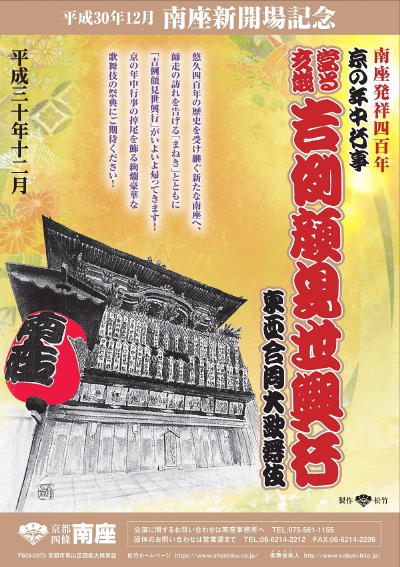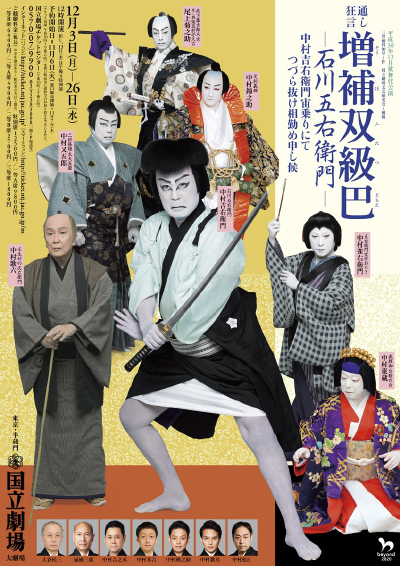| Comments |
The traditional kaomise in Ky˘to. The first one since the reopening of the theater in Spring 2018 and ... the last one for the Heisei era.
Terakoya: Genz˘ and his wife Tonami run a small school and are
protecting Kan Sh˘j˘'s son and heir, saying that he is their son. However,
word has gotten out Kan Sh˘j˘'s son is there and Genz˘ has been ordered to
behead him. Moreover, Matsu˘maru is to come to inspect the head. Their only
alternative is to kill one of the other students as a substitute, but all of
the students are farmer's children who could never pass for the son of a court
aristocrat. However, a new boy arrives that day and Genz˘ makes the terrible
decision to kill him in the place of his lord. As it turns out, Matsu˘maru has
sent his own son to be sacrificed, because of his family's long loyalty to
Kan Sh˘j˘. But he must face the most terrible situation for a father,
inspecting the head of his own son and lying when he says that it is the
genuine head of the son of Kan Sh˘j˘. Finally Matsu˘maru reveals his true
feelings to Genz˘ and he and his wife Chiyo mourn their dead son.
Starring Nakamura Shikan as Matsu˘maru, Kataoka Ainosuke as Genz˘, Nakamura Kaishun as Chiyo and Nakamura Senjaku as Tonami.
Featuring also Nakamura Kikaku as Shund˘ Genba.
Toribeyama Shinjű:
(The Love Suicides at Toribeyama)
This play by 20th century playwright Okamoto Kid˘ mixes old and new Kabuki styles.
The samurai Hankur˘ (Nakamura Baigyoku) is in love with the courtesan Osome (Kataoka Takatar˘).
Visiting her one night in the pleasure quarters of Ky˘to, he gets into a
drunken quarrel and ends up killing a man in a fight. Knowing that execution
awaits him, the two lovers decide to die together instead.
Hankur˘ and Osome travel the road to death in new kimono that ironically
were made for them to celebrate the New Year together. Featuring also Ichikawa Sadanji, Ichikawa Udanji, Kataoka Ichiz˘ and Nakamura Kaishun.
Jiisan Baasan: based on a short story by Mori ďgai, this modern play
by Uno Nobuo shows a loving young couple. The samurai Iori travels to Ky˘to with
his lord, leaving Run, his beloved wife, behind. While there, he attacks another
man in a fight over a sword and is forced into house arrest, separating him from
his wife. Many years later, he returns to his home as an old man.
There he meets an elderly woman and they do not recognize each other
until she sees the one thing that has not changed with age,
Iori's peculiar habit of putting his hand to his nose.
Starring Living National Treasure Kataoka Nizaemon and Nakamura Tokiz˘ as Iori and Run. Featuring also Nakamura Shikan, Kataoka Ainosuke, Kataoka Takatar˘, Kataoka Ichiz˘ and Ichikawa Komaz˘.
Ninokuchi-mura: in the pleasure quarters, the most important possessions were money and reputation.
In danger of losing his lover, the courtesan Umegawa (Nakamura Senjaku), the money courier Kameya Chűbŕ (Living National Treasure Sakata T˘jűr˘) breaks the seals on a
package of money entrusted to him after being taunted by a rival, even though the use of such money is punishable
by death. In this scene, on their way to love suicide, the couple go through the snow covered landscape on
their way to the man's home town where they will meet their end. Featuring also Nakamura Ganjir˘ in the role of Chűbŕ's father Magoemon.
Yoshitsune Senbon Zakura: this is section of an epic originally
written for the Bunraku puppet theatre.
The full-length play shows the fate of various Heike generals in hiding after
the victory of their enemy, the Genji.
Konomi/Kokingo Uchijini:
(The Chestnut Tree and The Death of Kokingo)
Wakaba-no-Naishi (Kataoka Takatar˘), the wife of the Heike commander Koremochi travels with
her young son and their retainer Kokingo (Kataoka Sennosuke), searching for her husband.
While resting in a small mountain village, they are met by Gonta (Living National Treasure Kataoka Nizaemon),
a local bully who skillfully cons them out of their money. Later they are set upon
by Genji forces, and in a spectacular fight scene, Kokingo sacrifices himself to
save his mistress and her son.
Sushiya:
(The Sushi Shop)
Gonta's father Yazaemon (Ichikawa Sadanji) runs a sushi shop,
but was formerly a retainer of Taira Koremochi. With his clan defeated,
Koremochi (Nakamura Tokiz˘) now lives with Yazaemon's family disguised as a humble apprentice.
Innocently, Yazaemon's daughter, Osato (Nakamura Senjaku) is in love with him.
But knowing of the bounty on Koremochi's head, her brother Gonta kills him and
turns his wife and child over to the Genji commander. Furious at his son,
Yazaemon stabs him, but before his death, Gonta reveals that he only
pretended to kill Koremochi and sacrificed his own wife and son to save
the real Koremochi and his family.
Men Kaburi: this is a dance portraying a little boy at his games.
An adult Kabuki actor (Nakamura Ganjir˘) will depict skillfully the innocent cheerfulness of a child.
He first dances showing how he plays usually, but will then put on the mask of a monkey,
pretending to be one himself. However, as the lyrics mention about a horse, he pulls together
the reigns and shows the movements of riding a horse. This dance is rarely performed.
Benten Musume: this play is a sewamono (realistic play about commoners)
written by the late 19th century playwright Mokuami who is famous for his plays about thieves.
The thief Benten Koz˘ dresses up as a woman to commit extortion, but his plans are ruined when his disguise is seen through.
In the highlight of the play, he undresses, showing his colorful tattoos and introduces himself in a famous poetic speech.
Afterwards, he is joined by the members of his gang on a riverbank, and,
using the playwright's famous poetic rhythms, in turn, they each boast of their careers as thieves.
Kataoka Ainosuke stars as Benten Koz˘, with Nakamura Shikan as Nippon Daemon,
Ichikawa Udanji as Nang˘ Rikimaru,
Nakamura Ganjir˘ as Tadanobu Rihei and Kataoka Takatar˘ as Akaboshi Jűzabur˘.
Sanja Matsuri: a vigorous dance starring Kataoka Sennosuke and Nakamura Takanosuke.
It is based on dolls at the Sanja festival
showing the founding of the temple at Asakusa
when two fishermen found a golden image of the Kannon
in their nets. In this case, the holy spirits that they encounter are two spheres
with the characters for "good" and "evil" on them, and the spirits possess
the two and animate them into a lively dance.
Sources: Earphone Guide Website or Sh˘chiku Kabuki Official Website
|




